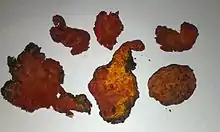| Taiwanofungus camphoratus | |
|---|---|
 | |
| Scientific classification | |
| Domain: | Eukaryota |
| Kingdom: | Fungi |
| Division: | Basidiomycota |
| Class: | Agaricomycetes |
| Order: | Polyporales |
| Genus: | Taiwanofungus |
| Species: | T. camphoratus |
| Binomial name | |
| Taiwanofungus camphoratus (M.Zang & C.H.Su) Sheng H.Wu, Z.H.Yu, Y.C.Dai & C.H.Su (as comphoratus) (1994) | |
| Synonyms[1] | |
| |
Taiwanofungus camphoratus, also known as stout camphor fungus (Chinese: 牛樟芝), is a species of fungus that is endemic to Taiwan, where it grows only on the endemic tree Cinnamomum kanehirae, causing a brown heart rot. Synonyms include Antrodia camphorata and Ganoderma camphoratum.
Genome
Recently, the 32.15 Mb genome containing 9,254 genes was sequenced.[2]
Chemical constituents
Antcin B, antrodioxolanone, antrocamphin B, antroquinonol, antrocamphins, zhankuic acids, and other antcins have been reported as constituents of Taiwanofungus camphoratus.
Ecological concern
Because of its use as an herbal remedy, fruiting bodies of the fungus can fetch high prices. Good quality fruiting bodies were reported to cost as much as US$15,000/kg in 1997, before artificial cultivation methods were developed.[3] Some have illegally farmed the fungus in the forests of Taiwan by hollowing out endangered stout camphor trees (Cinnamomum kanehirae or niu zhang Chinese: 牛樟).[4] This is despite the equal potency of T. camphotatus grown in a laboratory.[5]
References
- ↑ "Taiwanofungus camphoratus". NCBI Taxonomy. Bethesda, MD: National Center for Biotechnology Information. Retrieved 2 October 2017.
Antrodia camphorata synonym: Taiwanofungus comphoratus synonym: Ganoderma comphoratus synonym: Ganoderma camphoratum synonym: Antrodia cinnamomea
- ↑ Lu, MY.; Fan, WL.; Wang, WF.; Chen, T.; Tang, YC.; Chu, FH.; Chang, TT.; Wang, SY.; Li, MY.; Chen, Y. H.; Lin, Z. S.; Yang, K. J.; Chen, S. M.; Teng, Y. C.; Lin, Y. L.; Shaw, J. F.; Wang, T. F.; Li, W. H. (Oct 2014). "Genomic and transcriptomic analyses of the medicinal fungus Antrodia cinnamomea for its metabolite biosynthesis and sexual development". Proc Natl Acad Sci U S A. 111 (44): E4743–52. Bibcode:2014PNAS..111E4743L. doi:10.1073/pnas.1417570111. PMC 4226107. PMID 25336756.
- ↑ Wu SH, Ryvarden L, Chang TT (1997). "Antrodia camphorata ("niu-chang-chih"), new combination of a medicinal fungus in Taiwan". Bot Bull Acad Sin. 38: 273–275.
- ↑ China Post news staff (12 March 2012). "Taitung takes action to help prevent loss of Ligavon's last ancient camphor". Taiwan: The China Post. Retrieved 12 March 2012.
Many timber thieves drill away stout camphor trunks, collecting the fungi, selling the timber, and leaving gigantic "tunnels" in the enormous trees' trunks.
- ↑ China Post news staff (2 March 2010). "Cultivated camphor fungi as effective as wild ones". Taiwan: The China Post. Retrieved 12 March 2012.
The medical effect of wild stout camphor fungi (牛樟芝) is the same as cultivated ones, according to a study of the Department of Forestry at National Chung Hing University (NCHU).
External links
- Taiwanofungus camphoratus in Index Fungorum
 Media related to Taiwanofungus camphoratus at Wikimedia Commons
Media related to Taiwanofungus camphoratus at Wikimedia Commons Data related to Taiwanofungus camphoratus at Wikispecies
Data related to Taiwanofungus camphoratus at Wikispecies